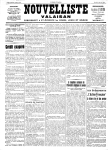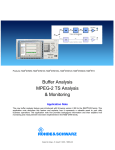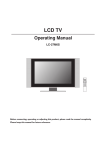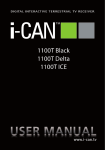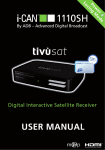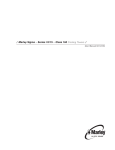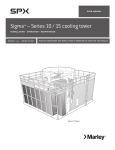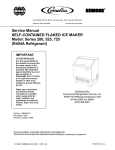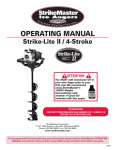Download Microscan MS-3000 User`s manual
Transcript
MS-520 Scan Head User's Manual P/N 83-000500 Rev E Information and specifications in this manual are subject to change without notice. Copyright © 2007 by Microscan Systems, Inc., 1201 S.W. 7th Street, Renton, Washington, U.S.A. 98057 (425) 226-5700 FAX: (425) 226-8682 All rights reserved. The information contained herein is proprietary and is provided solely for the purpose of allowing customers to operate and/or service Microscan manufactured equipment and is not to be released, reproduced, or used for any other purpose without written permission of Microscan. Throughout this manual, trademarked names might be used. Rather than put a trademark (™) symbol in every occurrence of a trademarked name, we state herein that we are using the names only in an editorial fashion, and to the benefit of the trademark owner, with no intention of infringement. Warranty Information Microscan Systems, Inc. warrants products manufactured by it to be free from defects in material or workmanship under normal use and service for a period of one year from date of shipment. This warranty is specifically limited to the replacement or repair of any such warrantable defects, without charge, when the complete product is returned to Microscan Systems, Inc., freight prepaid, at the address shown above. Contact the factory at the address above for a Return Material Authorization (RMA) number before returning the product. Microscan Systems, Inc. shall be the sole judge of the warrantability of alleged product defects. Products that are returned for warranty examination and that are found to be non-warrantable are chargeable and are returned freight collect. Upon request, an estimate will be provided before any chargeable repairs are attempted. A hard copy of a purchase order with the amount of the charge must be received by Microscan, either by mail or by FAX, before any equipment is returned. Warrantable products are repaired or replaced at no charge and returned freight prepaid. THIS EXPRESS WARRANTY EXCLUDES ALL OTHER WARRANTIES, EXPRESS OR IMPLIED, INCLUDING, BUT NOT LIMITED TO, IMPLIED WARRANTIES OF MERCHANTABILITY AND FITNESS FOR PURPOSE. MICROSCAN SYSTEMS, INC., SHALL NOT BE LIABLE FOR WARRANTY IN ANY AMOUNT EXCEEDING THE PURCHASE PRICE OF THE GOODS. MICROSCAN SYSTEMS, INC., SHALL NOT BE LIABLE FOR ANY SPECIAL, INCIDENTAL, OR CONSEQUENTIAL DAMAGES, WHETHER IN CONTRACT, TORT, OR OTHERWISE. The buyer acknowledges that he/she is not relying on the seller's skill or judgment to select or furnish goods suitable for any particular purpose and that there are no warranties that extend beyond the description on the face hereof. This warranty extends only to the original purchaser, and shall not apply to any products or parts that have been subject to misuse, neglect, accident, or abnormal conditions or operations. Claims for damage in transit are directed to the freight carrier upon receipt. ii MS-520 Scan Head User’s Manual Table of Contents List of Illustrations .................................................................................. iv List of Tables.......................................................................................... iv About This Manual .................................................................................iv Keystroke Entries ....................................................................................iv Approvals ............................................................................................... v Warning and Caution Summary ............................................................. v Safety Labels .........................................................................................vi Chapter 1 Introduction MS-520 Scan Head Description........................................................... 1-2 FIS Options .......................................................................................... 1-3 Interfacing with Decoders .................................................................... 1-6 The Scanning System .......................................................................... 1-6 Chapter 2 Setup Setup Goals ......................................................................................... 2-2 Label Orientation.................................................................................. 2-3 Tilt, Skew, and Pitch ............................................................................ 2-5 Object Detector Orientation ................................................................. 2-5 Read Ranges ....................................................................................... 2-6 Calculating the Number of Scans ........................................................ 2-8 Chapter 3 Installation Mounting the Scan Head.......................................................... 3-2 Cabling ..................................................................................... 3-3 Operational Tips ....................................................................... 3-4 Appendices Appendix A — Scan Head Specifications ............................................A-2 Appendix B — Optional Equipment .....................................................A-5 Appendix C — Glossary of Terms .......................................................A-7 Index ................................................................................................ I-1 MS-520 Scan Head User’s Manual iii List of Illustrations Figure 1-1 Back View of MS-520 Scan Head Scanning a Label ............... 1-2 Figure 1-2 Laser Beam Spot Types (not to scale) ..................................... 1-4 Figure 1-3 Scan Beam Types, Side Views ................................................ 1-4 Figure 1-4 Single Line and Raster Scan Patterns ..................................... 1-4 Figure 1-5 Scan Head to Decoder Cabling ................................................ 1-6 Figure 1-6 System Diagram ....................................................................... 1-6 Figure 2-1 Ladder Orientation.................................................................... 2-3 Figure 2-2 Picket Fence Orientation .......................................................... 2-3 Figure 2-3 Angled Picket Fence Orientation .............................................. 2-4 Figure 2-4 Tilt, Skew, and Pitch Axes ........................................................ 2-5 Figure 2-5 MS-520 Scan Width and Range ............................................... 2-6 Figure 2-6 Label Dimensions ..................................................................... 2-8 Figure 2-7 Label Orientations .................................................................. 2-10 Figure 3-1 MS-520 Bottom Mounting Holes (full size) ............................... 3-2 Figure 3-2 Scan Head/Decoder Interface Cable ....................................... 3-3 Figure A-1 Mechanical Dimensions ........................................................... A-2 Figure A-2 MS-520 Bottom Mounting Plate (not full size) .......................... A-5 Figure A-3 Universal Stand......................................................................... A-6 List of Tables Table 1-1 Available MS-520 Options (VLD)............................................... 1-3 Table 1-2 Available MS-525 Options (IR) .................................................. 1-3 Table 1-3 Raster Heights per Label Distance ............................................ 1-5 Table 2-1 MS-520 Read Ranges and Scan Widths ................................... 2-7 About This Manual This manual provides complete information on setting up and installing the MS-520 fixed-mount scan head. Unless otherwise noted, this manual applies to the MS-525 infrared laser beam scan head as well as the MS-520. Keystroke Entries Keystrokes to be entered from your terminal are highlighted in bold, as in <D>, including a < left angle bracket symbol (unless redefined by Command Start Character command) and followed by a > right angle bracket symbol. iv MS-520 Scan Head User’s Manual Approvals This equipment is approved for use by the following organizations: • CDRH (Center for Devices & Radiological Health) • UL (Underwriters Laboratories, Inc.) • CSA (Canadian Standards Association) • TüV (Technischer überwachungs-Verein) (MS-520 only) Warning and Caution Summary Note: The MS-520 scan head is designed to be connected to the MS-3000 decoder (single or dual). When installed, direct current power for the scan head is provided by the deocder. WARNING Use of controls, adjustments, or performance of procedures other than those specified herein may result in hazardous laser light radiation exposure. WARNING Up to 5 mW of laser diode power can be present in the interior. Avoid opening the scan head. Inspect housing to verify that loose casings or panels do not allow access to laser light. WARNING The laser beam can be harmful to eyesight. Avoid direct eye con tact with the laser beam. Never point the beam at other people, or in a direction where people may be passing. MS-520 Scan Head User’s Manual v Safety Labels 1201 S . W . 7th S t . R enton, W A 98055 LIS TE D A C C E S S O R Y R U L 1 95 0 4K 68 CL AS S FIS NU MB ER SER IAL NU M BE R M ANU FACT UR E D M O DEL P R O D U C T C O N F O R M S TO D H H S 2 1 C F R S U B C H A P TE R J. U S E D W IT H M S - 30 00 D E C O D E R + 12V 50m A P A T E N T N O . 5,2 39, 16 9 - 12V 35m A + 5V 240m A 11 -1 20 00 8 -0 1 Top Label vi MS-520 Scan Head User’s Manual M A D E IN U S A Back Label Introduction 1 Chapter Contents MS-520 Scan Head Description........................................................... 1-2 FIS Options .......................................................................................... 1-3 Interfacing with Decoders .................................................................... 1-6 The Scanning System .......................................................................... 1-6 Unless otherwise noted, this manual applies to the MS-525 scan head (infrared laser beam) as well as the MS-520. MS-520 Scan Head User’s Manual 1-1 1–Introduction Chapter 1–Introduction Chapter 1 Introduction MS-520 Scan Head Description The MS-520 scan heads use a high-speed, ten-sided spinning mirror to direct laser beams across bar code labels (figure 1-1) and convert the reflected light to waveforms. To Microscan decoder Figure A-1 Back View of MS-520 Scan Head Scanning a Label Figure 1-1 shows a MS-520 scan head in operation. Standard features of the MS-520 include low power consumption, wide field of view, the ability to read a complete range of code densities (from .0047 inch to .040 inch and larger, depending on range option), at scan speeds of 330 scans per second. Visible (MS-520 model) or infrared (MS-525 model) laser diode light wavelengths are available. 1-2 MS-520 Scan Head User’s Manual FIS Options FIS (Final Instruction Sheet) numbers are assigned to each customer order. The MS-520 models are available in standard FIS options, listed in tables 1-1 and 1-2. Table A-1 Available MS-520 Options (VLD) Spot Type Scan Beam FIS-0520-0001 FIS # Round Single Line Standard Range FIS-0520-0002 Round Raster Standard FIS-0520-0003 Round Single Line UHDa FIS-0520-0004 Round Raster UHD FIS-0520-0009 Oval Single Line Standard FIS-0520-0010 Oval Raster Standard FIS-0520-0011 Oval Single Line UHD FIS-0520-0012 Oval Raster UHD a. Ultra High Density Table A-2 Available MS-525 Options (IR) FIS # Spot Type Scan Beam Range FIS-0525-0005 Round Single Line Standard FIS-0525-0006 Round Raster Standard FIS-0525-0007 Round Single Line UHD FIS-0525-0008 Round Raster UHD FIS-0525-0013 Oval Single Line Standard FIS-0525-0014 Oval Raster Standard FIS-0525-0015 Oval Single Line UHD FIS-0525-0016 Oval Raster UHD MS-520 Scan Head User’s Manual 1-3 1–Introduction FIS Options 1–Introduction Chapter 1 Introduction Spot Options The laser beam on the scan head can be projected on the bar code label as a round or an oval spot, as shown in figure 1-2. Oval scan spot Round scan spot An oval spot is recommended for labels with voids, extraneous ink, or other imperfections. Figure A-2 Laser Beam Spot Types (not to scale) Scan Beam Options Scan beams (figures 1-3 and 1-4) are projected either as a single line or as a raster pattern, depending on the FIS option ordered. Raster option Single line option Figure A-3 Scan Beam Types, Side Views 10 raster scan lines Scan line Voids Single line option Raster option Figure A-4 Single Line and Raster Scan Patterns Note: Unless otherwise noted, laser beams are represented as a single line throughout this manual. 1-4 MS-520 Scan Head User’s Manual FIS Options Scan beams projected across a label appear as a single scan line, as shown on the left label in figure 1-4. Raster Option The raster option projects ten individual scan lines through 2 degrees of arc with each rotation. Table 1-3 shows estimated heights of raster images at selected scan ranges, measured from the front of the scan head. Table A-3 Raster Heights per Label Distance Scan Range Raster Height 2 inches (50.8 mm) .10 inch (2.54 mm) 4 inches (101.6 mm) .17 inch (4.32 mm) 6 inches (152.4 mm) .24 inch (6.1 mm) 8 inches (203.2 mm) .31 inch (7.87 mm) 10 inches (254 mm) .38 inch (9.65 mm) Range Options All models are available in standard and ultra high density (UHD) optics. See “Read Ranges” in chapter 2, “Setup” for specific range data. Interfacing with Decoders The MS-520 scan head consists of a scan head only. To decode and transmit bar code data, a separate series 3000 single (figure 1-5) or dual head decoder is required (via an 8-pin modular cable). For information on configuration and decoder setup, see the decoder user's manual. PWR TRIG SCAN IND 1 IND 2 Figure A-5 Scan Head to Decoder Cabling MS-520 Scan Head User’s Manual 1-5 1–Introduction Single Line Option 1–Introduction Chapter 1 Introduction The Scanning System Figure 1-6 shows a possible scanning system setup. Bar-coded item flow Optional monitor MS-3000 or other Microscan decoder Object Detector 8-pin cable To optional multidrop concentrator Power pack MS-520 Scan Head Figure A-6 System Diagram 1-6 Host MS-520 Scan Head User’s Manual To 120/240 VAC power supply Chapter Setup 2 2–Setup Chapter Contents Setup Goals ......................................................................................... 2-2 Label Orientation.................................................................................. 2-3 Ladder Orientation ....................................................................... 2-3 Picket Fence Orientation ..............................................................2-3 Angled Picket Fence Orientation ................................................. 2-4 Tilt, Skew, and Pitch............................................................................. 2-5 Object Detector Orientation.................................................................. 2-5 Read Ranges ....................................................................................... 2-6 Calculating the Number of Scans......................................................... 2-8 Ladder Calculation ....................................................................... 2-9 Picket Fence Calculation ............................................................. 2-9 Comparing Label Orientation Calculations ................................ 2-10 This chapter provides instructions for orienting the MS-520 scan head in relation to labels, object detectors, read ranges, and ensuring a minimum number of scans. Careful evaluation of the specific application, including the number, type, and location of scan heads, decoders, and object detectors, as required, is a prerequisite to successful bar code scanning. MS-520 Scan Head User’s Manual 2-1 Chapter 2 Setup Setup Goals To achieve the desired number of scans required by the application, scan heads must be positioned so that the scan beam crosses a label within the read range. To accomplish this, refer to the range table, bar code label orientations, scan calculations, and scan head orientation, as described in this chapter. In addition, a read rate test (see your decoder user’s manual) should be performed to ensure that optimum scanning and decoding is occurring. 2–Setup Determine the following before installation: a. Label Orientation. Position the scan head and label so that the label is given as many scans as possible. (Take into account, and adjust, if necessary, label speed and/or the distance between bar-coded objects.) Avoid angles that result in direct (specular) reflected light, or blurring. b. Object Detector Orientation. Position object detector (if used) so that the detector senses the object before the scan head can read it, and ensure that object detector light does not reflect back into the scan head sensor. c. Read Range. Position the scan head at a distance from the label that is within the ranges specified by your application and verify ranges by performing a read rate test. d. Number of Scans. Ensure that each label receives the minimum required number of scans for your application. 2-2 MS-520 Scan Head User’s Manual Label Orientation Label Orientation If the bar code label bars are parallel to the direction of travel, as shown in figure 1-1, the label is said to be in a ladder orientation; if the bars are perpendicular with the direction of travel, the label is said to be in a picket fence orientation (figure 1-2). Ladder Orientation, Direction of label travel 2–Setup In general, depending on label size and speed, ladder orientation is preferable because different portions of the label are scanned as the label goes by. In addition label placement is not as critical. As shown in figure 2-1, a label can be can be successfully read if placed anywhere within the scan line. Scan Line Figure 2-1 Ladder Orientation Picket Fence Orientation Unlike ladder, picket fence allows only a small portion of the entire label to be scanned. As a result, labels must be of good quality since even slight label imperfections such as extraneous ink, voids, etc., can cause misreads or non-reads. (See figure 1-5 in chapter 1.) Direction of label travel Scan Line Figure 2-2 Picket Fence Orientation Note: Either ladder or picket fence can be rotated without losing its orientation, provided that the label’s direction of travel does not change in relation to the scan line. MS-520 Scan Head User’s Manual 2-3 Chapter 2 Setup Angled Picket Fence Orientation The problems associated with picket fence can be minimized by slightly tilting the scan line (figure 2-). This allows a larger portion of the label to be scanned and increases the label placement area by “simulating” the ladder orientation. This of course is impractical with a short bar code height. 2–Setup Angled picket fence is recommended only where the bar code is reasonably tall and the label speed is not too fast in relation to the scan field width, since angling the label will reduce the number of scans on the label. Direction of label travel Scan Line One advantage of the picket fence over the ladder orientation is in the area of label Figure 2-3 Angled Picket Fence Orientation speed. In ladder mode, the label travel distance is the height of the bar code; in picket fence mode, the label can be read while it travels the full distance of the scan width. 2-4 MS-520 Scan Head User’s Manual Tilt, Skew, and Pitch Tilt, Skew, and Pitch Tilt refers to the label rotation, relative to the scan head, as it rotates on the tilt axis, as shown in figure 2-4. Skew Axis Tilt Axis MS-520 Scan Head Pitch Axis 2–Setup Skew refers to the angle of the label, relative to the scan head, as it rotates on the skew axis, as shown in figure 2-4. MS-520 scan heads can be skewed to a maximum of ±40 degrees from the centerline. Bar Code Label Figure 2-4 Tilt, Skew, and Pitch Axes Pitch refers to the position of the label, relative to the scan head, as it rotates on the pitch axis. Maximum pitch is ±50 degrees from the centerline. For the MS-520, pitch angles between +3 and +5 degrees should be avoided since they may cause specular reflection, the return of direct, non-diffuse light. Object Detector Orientation Microscan products can be triggered from either a host or an object detector. An object detector uses infrared light to detect the presence of a bar-coded object and relays that information to the decoder, which will, if correctly configured, initiate a read cycle. Typically, a detector is positioned so that it will detect the presence of an object before the object’s label can be scanned by the scan head. An object detector is mounted in any position relative to the object as long as (1) the object passes within range of the detector and (2) direct or reflected light from the detector beam does not interfere with the scan head’s reception. MS-520 Scan Head User’s Manual 2-5 Chapter 2 Setup Read Ranges A label must be within the read range—the zone, as measured from the front of the scan head bezel, in which a label can be reliably read. Scan Width cm 15 in. 6 10 5 4 5 3 2 0 1 0 5 1 2 10 3 4 15 5 6 2–Setup 10 25 9 20 6 15 5 4 10 Infrared Laser 7 Visible Laser 8 3 2 5 1 MS-520 0 0 in. cm Range Figure 2-5 MS-520 Scan Width and Range Figure 1-5 shows the read ranges of visible and infrared MS-520 scan heads. See table 1-4 for ranges and scan widths1 per label densities (narrow-bar-widths). 1. Scan Width is the distance across the scan beam in which a given label can be reliably read. Scan width varies with read range. The greater the scan width, the longer a moving label will be readable and the greater the number of expected scans. 2-6 MS-520 Scan Head User’s Manual Read Ranges Table 1-4 MS-520 Read Ranges and Scan Widths* Maximum Scan Width Narrow-Bar-Width Read Range .0047” (.119 mm) 1.75–3” (45–76 mm) 3” (76 mm) .0075” (.191 mm) 1–4” (25–102 mm) 4” (102 mm) .0075” (.191 mm) 2–5” (51–127 mm) 4.75” (121 mm) .010” (.254 mm) 1.5–6” (38–152 mm) 6” (152 mm) .015” (.381 mm) 1–7” (25–178 mm) 7.5” (191 mm) .020” (.508 mm) 1–9” (25–229 mm) 9.25” (235 mm) .030” (.762 mm) 4–10” (102–254 mm) 9.5” (241 mm) .040” (1.02 mm) 4–10” (102–254 mm) 9.5” (241 mm) .050” (1.27 mm) 5–10” (127–254 mm) 9.75” (248 mm) Visible Laser UHD Range Standard Range UHD Range Standard Range * .0047” (.119 mm) 1.75–3” (45–76 mm) 3” (76 mm) .0075” (.191 mm) 1.25–3” (32–76 mm) 3.5” (89 mm) .0075” (.191 mm) 2–4.5” (51–114 mm) 3.5” (89 mm) .010” (.254 mm) 1.5–5” (38–127 mm) 4.75” (1.21 mm) .015” (.381 mm) 1–6” (25–152 mm) 6” (152 mm) .020” (.508 mm) 1–7” (25–178 mm) 7” (178 mm) .030” (.762 mm) 4–9” (102–229 mm) 8.5” (216 mm) .040” (1.02 mm) 4–9” (102–229 mm) 8.5” (216 mm) .050” (1.27 mm) 5–9” (127–229 mm) 8.5” (216 mm) Performance may vary slightly for raster units. To achieve optimum performance with your application, 1. Configure the decoder for read rate mode.1 b. Temporarily position the scan head. c. Map out a label placement area by manually moving your label in and out and back and forth while observing read rates on the screen. Read rates will vary due to differences in label quality, positioning, etc. 1. See the decoder user’s manual for read rate test information. MS-520 Scan Head User’s Manual 2-7 2–Setup Infrared Laser Chapter 2 Setup Calculating the Number of Scans To ensure reliable scanning, it is recommended that a minimum of five scans be applied to each label. 2–Setup The number of scans that a given label will receive can be calculated by formulas for both ladder and picket fence label orientations if the inputs listed below are known. • Scan Rate (SR) is the number of scans per second that a given scan head is capable of Label length emitting. • Scan Width (SW) is the width Label across the scan beam, at a height given distance from the scan head, in which a label can be Quiet zones read. • Label Speed (LS) is the disFigure 2-6 Label Dimensions tance per second that a label moves as it travels through the scan lines. • Label Length (LL) (for picket fence formula only) is the length of the longest printed label to be read plus the length of the quiet zones (figure 2-6). • Label Height (LH) (for ladder formula only) is a measurement of the height of individual bars (figure 2-6). . Note: Label length and label height are always measured as shown in figure 2-6, regardless of label orientation. 2-8 MS-520 Scan Head User’s Manual Calculating the Number of Scans Use the formula1 suitable for your application to predict the number of scans each label will receive. Ladder Calculation ( LH x SR LS ) – 3 = number of complete scans Example 1: LH = 1 inch 2–Setup LS = 10 inches per second SR = 330 scans per second ( 1 x 330 10 ) – 3 = 30 complete scans Picket Fence Calculation ( (SW – LL) x SR LS Example 2: ) – 3 = number of complete scans LL = 1 inch (including quiet zones) SW = 2 inches LS = 10 inches per second SR = 330 scans per second ( (2 – 1) x 330 10 ) – 3 = 30 complete scans Note: If the number of complete scans calculates out to less than the minimum required for your application, assign the desired value to the number of complete scans and solve for any other parameter that can possibly be changed, such as label length, scan width, or label speed. 1. The -3 component (in both formulas) is added to allow for the first and last scans, and an AGC scan. MS-520 Scan Head User’s Manual 2-9 Chapter 2 Setup Comparing Label Orientation Calculations When evaluating ladder versus picket fence orientations (figure 2-7), label height, label length, and scan width are critical parameters. Note that in both previous examples, a 1 inch square label yields the same number of complete scans (30). 2–Setup However, when label height or label length are changed, the resulting number of scans differs dramatically. For example, if both label height and label length are decreased to 0.5 inch for both examples (figure 2-7), the ladder orientation obtains 13 complete scans compared with 46 scans in the picket fence orientation. If label height and label length are both increased to 1.5 inches, the ladder rate goes up to 46 complete scans, compared to 13 complete scans in picket fence. Varying scan widths and label speeds will also alter the number of scans. Direction of Label Travel Ladder Orientation Picket Fence Orientation Figure 2-7 Label Orientations 2-10 MS-520 Scan Head User’s Manual Chapter 3 Installation Chapter Contents This chapter provides instructions for mounting the MS-520 scan head, interfacing with a decoder, and initial operation. Before permanently mounting the scan head, you should have read chapter 2, “Setup” and be confident that the scan head's mounting position and orientation will allow it to read the application's labels at the maximum read rate and with the desired number of scans. MS-520 Scan Head User’s Manual 3-1 3–Installation Mounting the Scan Head.......................................................... 3-2 Cabling ..................................................................................... 3-3 Operational Tips ....................................................................... 3-4 Chapter 3 Installation Mounting the Scan Head The MS-520 scan head can be mounted directly to a mounting surface of your choice, or indirectly, via a mounting plate and a universal stand. (See “Optional Equipment” on page A-5.) To permanently mount the scan head: 1. Position the scan head in a dry place, devoid of sunlight, bright lights, or light from other sources. 2. Before mounting, ensure sufficient clearance at the rear of the scan head to allow for the 8-pin, RJ-45 connector and cable. 3–Installation 3. If not using the mounting plate, use the measurements provided in figure 1-1 to locate centers of mounting holes and drill four 5/32 inch (4 mm) holes. If using the mounting plate and a universal stand (see “Optional Equipment” on page A-5), use the four perimeter holes for mounting the plate and mount scan head directly to the four inner holes on the plate. 4. Secure scan head with four 6-32 screws. 2.25" (57.15 mm) 1.40" (35.56 mm) .43" (10.92 mm) .32" (8.128 mm) 2.50" (63.5 mm) 1.50" (38.10 mm) 2.25" (57.15 mm) 6-32 threads (4 places) Figure 3-1 MS-520 Bottom Mounting Holes (full size) Caution: Do not allow the mounting screws to penetrate into the scan head case more than .175 inch (4.4 mm) or damage to the scan head may result. 3-2 MS-520 Scan Head User’s Manual Cabling Cabling The standard cable supplied with a MS-520 scan head is 6 feet (1.83 cm) in length, wired with an 8-pin RJ-45 modular plug at each end. 1 1 8 8 Scan Head +12 VDC in -12 VDC in Ground +5 VDC in Scan Sync out Scan Head Disable in Video (-) out Video (+) out Bare wire 3–Installation 1 2 3 4 5 6 7 9 Decoder Figure 3-2 Scan Head/Decoder Interface Cable P/N: 61-130001-XX Cables are also available in lengths from 1 to 15 feet, and are represented by a cable part number. For example, if 01 is substituted for XX in part number (PN) 61-130001-XX in figure 1-2, then the cable length would equal 1 foot (30.5 cm). To prevent voltage loss, cables between the decoder and scan head should not exceed 15 feet (5.9 m) unless wire sizes exceed the minimum 26 AWG, or power supply voltages at the scan head are verified to be within 8 percent. MS-520 Scan Head User’s Manual 3-3 Chapter 3 Installation Operational Tips Do: • Check the label for readability in the visible (670 nm) or infrared (780 nm) range. If there is any question about the readability of the label, contact your Microscan representative. • Check inputs (label speed, length, height, etc.) to ensure the minimum number of scans per label required for your application. • As much as possible, avoid excessive tilt, pitch, and skew of the bar code label. • Test scan head readability with a label that is known to be good and log the results. • Clean the laser window on a regular basis with a clean, dry Q-tip or cotton cloth, without using excessive force. 3–Installation Do Not: • Aim the scan head into sunlight, photo detectors, or other light-emitting sources. • Obstruct the laser window with mounting hardware or other objects. • Connect chassis of scan heads, decoders, and host to different ground potentials. • Operate the scan head in excessive temperature environments (see appendix A, “Scan Head Specifications”). • Connect or disconnect scan head/decoder interface cable while decoder power is ON. 3-4 MS-520 Scan Head User’s Manual Appendices Contents Appendix A — Scan Head Specifications ............................................A-2 Appendix B — Optional Equipment .....................................................A-5 Appendix C — Glossary of Terms .......................................................A-7 Appendices MS-520 Scan Head User’s Manual A-1 Appendices Appendix A — Scan Head Specifications Except where otherwise noted, the following specifications are true for all MS-520 scan heads: Physical Length ............ 2.25 in. (57.15 mm) Width............... 2.25 in. (57.15 mm) Height.............. 2.25 in. (57.15 mm) Cable Length... 6 ft. (183 cm) standard Interface Connector RJ-45 8-pin modular socket Weight............. 8 oz. (227 g) Scanning Parameters Type ................ Rotating 10-sided mirror Scan Rate ....... Up to 330 scans per second Scan Angle...... 60° Pitch ................ ±50° maximum Appendices Skew ............... ±40° maximum Figure A-1 Mechanical Dimensions A-2 MS-520 Scan Head User’s Manual Scan Head Specifications Laser Light Wavelength Safety class Operating life Visible Laser Infrared Laser 670 nm nominal CDRH Class II 50,000 hrs. @ 25° C 780 nm nominal CDRH Class I 400,000 hrs. @ 25° C Optical Composite read ranges for several Code 39 narrow-bar-width sizes at 2.5:1 wide-to-narrow bar ratios. See “Read Ranges” in chapter 2. Operating Ranges Visible Standard Range UHD Range 1 to 10 in. (2.54 to 25.4 cm) 1 to 4 in. (2.54 to 10.16 cm) Infrared 1 to 9 in. (2.54 to 22.86 cm) 1.25 to 3 in. (3.18 to 7.62 cm) Scan Width ......................................8.5 inches at an 8-inch distance Label Contrast: Visible: 25% min. absolute dark/light differential at 670 nm wavelength Infrared: 40% min. absolute dark/light differential at 780 nm wavelength Raster Image...................................10 raster scan lines over a 2-degree arc (or 0.24 inch raster at 6-inch distance) (Compatible with Microscan series 3000 decoder.) Port..................................................Socket for 8-pin RJ-45 modular connector Cabling ............................................6-foot cable standard, available in 1-foot increments to 15 feet MS-520 Scan Head User’s Manual A-3 Appendices Decoder Interface Appendices Electrical Power Requirements: +12 VDC @ 50 mA maximum, 20 mV p-p maximum allowed ripple -12 VDC @ 35 mA maximum, 20 mV p-p maximum allowed ripple +5 VDC @ 240 mA maximum, 200 mV p-p maximum allowed ripple Input Signals ................................... TTL high enable for laser-diode and motor (controlled by decoder software) Output Signals: Scan Sync: .... TTL level Video Out: .... RS-422 Interface 8-pin RJ-45 modular connector Pin Assignments: Pin 1: Pin 2: Pin 3: Pin 4: Pin 5: Pin 6: Pin 7: Pin 8: +12 VDC in –12 VDC in Ground +5 VDC in Scan sync out Scan Head Disable in Video (–) out Video (+) out Environmental Operating Temp.: Visible: Infrared: 32° to 104°F (0° to 40°C) 32° to 113°F (0° to 45°C) Storage Temperature...................... –58° to 158° F (–50° to 70° C) Appendices Humidity .......................................... Up to 95% (non-condensing) Ambient Light Immunity: 450 foot candles: ..... Indoor: fluorescent, incandescent, mercury vapor, sodium vapor 2000 foot candles: ...... Soft outdoor A-4 MS-520 Scan Head User’s Manual Optional Equipment Appendix B — Optional Equipment Mounting Plate Kit Part Number: 98-500002 To mount the scan head with the mounting plate, “pair up” the mounting plate’s four inner screw holes to the scan head’s mounting holes (see figure 3-1 in chapter 3, “Installation”) and attach plate to scan head. Next, mount entire assembly using the four outer holes on the plate. 3.3" (83.82 mm) 0.25" (6.35 mm) 2.1" (53.34 mm) Four countersunk holes, for attaching plate to scan head Four 0.156" (3.96 mm) Diameter holes, used to mount plate to any suitable surface 2.8" (71.12 mm) Thickness of Plate = 0.1" (2.54 mm) 1.5" (38.1 mm) 0.3" (7.62 mm) Appendices Figure A-2 MS-520 Bottom Mounting Plate (not full size) MS-520 Scan Head User’s Manual A-5 Appendices Universal Stand The Microscan Universal Stand is available in 4-inch, 6-inch, and 10-inch flex models as well as a 7-1/4" extension kit. 4-inch, knob adjustable handle 98-200008 6-inch, knob adjustable head and foot 98-200007 10-inch flax neck, adjustable head 98-200006 7-1/4-inch extension kit 98-200024 MS-520 Adapter plate 98-200011 4 inch Universal Stand 6 inch Universal Stand 10 inch Flex Neck Universal Stand Mates to adaptor plate Ball joint Adjust knob 4" 10.16 cm 6" 15.24 cm .25 " .635 cm 10 " 25.40 cm 2" 5.080 cm .190" DIA. .483 cm DIA. 4 PL 2.5 " 6.350 cm Appendices .25 " .635 cm 7-1/4-inch Universal Extension Kit Bottom 7.25" 18.42 cm 1.250 " 3.175 cm 1.125 " 2.858 cm Figure A-3 Universal Stand A-6 MS-520 Scan Head User’s Manual .50 " DIA.1.270 cm DIA. 3 Pl. .20 " DIA. .508 cm DIA. 3 PL 1.250 " 3.175 cm C L 1.125 " 2.858 cm Glossary of Terms Appendix C — Glossary of Terms Bar Code. Data that has been encoded into an array of parallel bars and spaces of varying widths. Bar Code Density. Number of characters per inch or other unit of measure. Decoder. A device that analyzes digital input provided by the scan head and translates it into bar code information. Focal Length. The distance measured from the scan head to the center of the depth of field, or focal point. Label Height. Regardless of orientation, the measurement taken along the length of a bar. Label Length. Regardless of orientation, the measurement taken across the label's bars from one end to the other, including the quiet zone. Label Speed. The rate in inches or centimeters per second that a label moves through the scan beam. Ladder Label Orientation. A bar code label in which the bars are parallel to the direction of travel. Mil. One thousandths of an inch or .0254 mm. In bar-coding, a measurement that identifies a bar code label by the width of its narrowest element. Number of Scans Calculation. The number of times a bar code label is scanned by the scan head during one pass through the laser beam. Object Detector. A photo electric device used to sense the presence or absence of an object. Picket Fence Label Orientation. A bar code label in which the bars are perpendicular to the direction of travel. Pitch. Label (or scan head) rotation around the center of the pitch axis. Port. An access point for data entry and exit. Read Range. The distances in which a label can be reliably read, as measured from the front of the scan head. Read Rate. The reading performance of the scan head for a given label based on the percentage of good reads per a determined number of scans. MS-520 Scan Head User’s Manual A-7 Appendices Oval Spot. An elongated laser beam involving custom optics that is designed to project lengthwise with the label's bars and spaces. Appendices Round Spot. The standard laser beam as it appears on the label being scanned, sometimes slightly ovalized. Scan Head. The module that projects laser light on bar code labels and receives reflected light back. This device changes the analog signal to a digital representation of the bar code and outputs it to a decoder. Scan Rate. Number of scan lines created by the scan head per second. Scan Width. The measurement (inches or centimeters) of the scan beam line at the readable scan range of a given application. Skew. Label (or scan head) rotation around the center of the skew axis. Specular Reflection. The direct, mirror-like reflection of laser light back to the scan head, causing over-light saturation. Tilt. Label (or scan head) rotation around the center of the tilt axis. Trigger. A signal, either external or serial, that initiates the read cycle and causes the decoder to expect label input. Appendices Wide-to-narrow Ratio. The ratio of the width of the widest (or wider) bar to the narrowest bar of a given bar code symbology. For example, 2:1, 2.5:1, 3:1, and 4:1. A-8 MS-520 Scan Head User’s Manual Index A N Ambient Light Immunity A-4 Angled Picket Fence Orientation 2-4 Approvals v Number of Scans (setup objective) 2-2 C Cable Length A-2 Cabling 1-6, 3-3 Calculating the Number of Scans 2-8 Caution Summary v D O Object Detector Orientation 2-2, 2-5 Operating life A-3 Operating Ranges A-3 Operational Tips 3-4 Optional Equipment A-5 P H R Height A-2 Humidity A-4 Installation 3-1 Interface Connector A-2 Interfacing with Decoders 1-6 Raster Height 1-5 Raster Image A-3 Raster Option 1-5 read cycle 2-5 Read Range (setup objective) 2-2 Read rate test 2-7 Reading Ranges and Scan Widths 2-7 L S Label Contrast A-3 Label Height 2-8 Label Length 2-8 Label Orientation 2-3 Label Speed 2-8 Ladder Orientation 2-3 Length A-2 Safety class A-3 Safety Labels vi Scan Angle A-2 Scan Beam Options 1-4 Scan Rate 2-8, A-2 scan speed 1-2 Scan Width 2-8 Scanning System (diagram) 1-6 Setup Goals 2-2 Signals (input/output) A-4 Single Line Option 1-5 Skew 2-5, A-2 Skew (definition) A-8 specular reflection 2-5 F I M Maximum pitch (±50) 2-5 Mounting Plate Kit A-5 Mounting the Scan Head 3-2 MS-520 Scanner User’s Manual Index FIS Options 1-3 Picket Fence Orientation 2-3 Pitch 2-5, A-2 Pitch (definition) A-7 Power Requirements A-4 Product Approvals. See Approvals Decoder Interface A-3 I-1 Index Spot Options 1-4 Standard features 1-2 T Temperature A-4 Tilt 2-5 Tilt (definition) A-8 U Universal Stand A-6 W Index Warning Summary v Warranty Information ii Wavelength A-3 Weight A-2 Width A-2 I-2 MS-520 Scanner User’s Manual




































